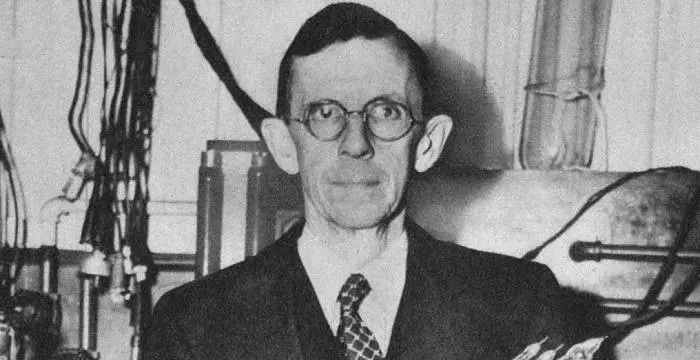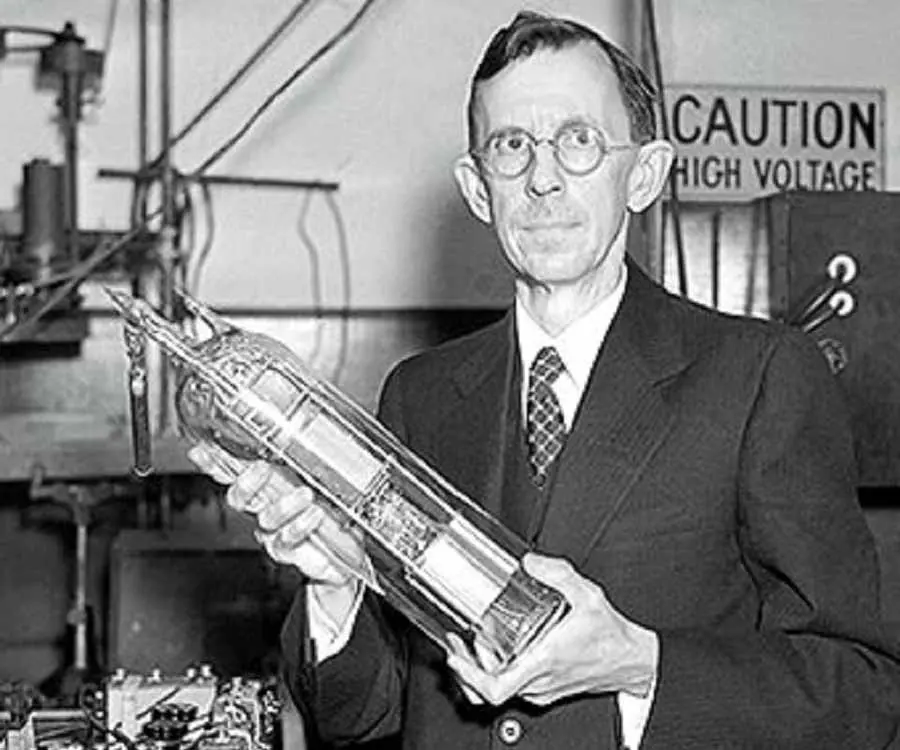
Clinton Davisson - Scientists, Facts and Facts
Clinton Davisson's Personal Details
Clinton Davisson was a Nobel Prize winning American physicist, known for his discovery of electron diffraction
| Information | Detail |
|---|---|
| Birthday | October 22, 1881 |
| Died on | February 1, 1958 |
| Nationality | American |
| Famous | Scientists, Physicists |
| Spouses | Charlotte |
| Siblings | Carrie |
| Known as | Clinton Joseph Davisson |
| Childrens | Clinton Owen, Elizabeth Mary, James Willans, Richard Joseph |
| Discoveries / Inventions |
|
| Birth Place | Bloomington, Illinois, USA |
| Gender | Male |
| Father | Joseph Davisson |
| Mother | Mary Calvert Davisson |
| Sun Sign | Libra |
| Born in | Bloomington, Illinois, USA |
| Famous as | Physicist |
| Died at Age | 76 |
// Famous Physicists
Henry Cavendish
Henry Cavendish was a theoretical chemist and physicist, renowned for discovery of hydrogen and calculation of the mass of earth. To know more about his childhood, profile, timeline and career read on
Walter Kohn
Nobel Laureate Walter Kohn was an Austrian-born American theoretical chemist and physicist. Check out this biography to know about his childhood, life, achievements, works & timeline.
Nikola Tesla
Nikola Tesla was a Serbian-American inventor, best known for his development of alternating current electrical systems. This biography of Nikola Tesla provides detailed information about his childhood, life, achievements, works & timeline.
Clinton Davisson's photo
Who is Clinton Davisson?
Clinton Joseph Davisson was a Nobel Prize winning American physicist, known for his discovery of electron diffraction. Born in late nineteenth century to a contract painter father, he had to support his own education from the very start. After graduating from Bloomington High School at the age of 21, he entered the University of Chicago in the same year. However, it took him around seven years to obtain his bachelor’s degree. For the greater part of his college years, he worked at the Princeton University as part time instructor, returning to the Chicago University only for the summer quarters. Rest of the time, he privately studied with eminent academics at Princeton, especially Professor O.W. Richardson. Late,r he did his doctoral work with Richardson and received his PhD in three years. Subsequently, he began his career as an Assistant Professor at Carnegie Institute of Technology; but very soon shifted to Western Electric Company, later renamed as Bell Telephone Laboratories. Here he spent his most productive years and performed the famous Davisson-Germer experiment, which resulted in the discovery of electron diffraction. Afterwards he joined University of Virginia as visiting professor of research, finally retiring from there after eight years.
// Famous Scientists
Juliane Koepcke
Juliane Koepcke is a German-Peruvian biologist, who was the lone survivor among the 92 passengers and crew of the ill-fated LANSA Flight 508 that crashed in the Peruvian rainforest on 24 December 1971. Know more about her life in this biography.
Henry Cavendish
Henry Cavendish was a theoretical chemist and physicist, renowned for discovery of hydrogen and calculation of the mass of earth. To know more about his childhood, profile, timeline and career read on
Konstantin Tsiolkovsky
Konstantin Tsiolkovsky was a Russian rocket scientist and a pioneer of astronautics. This biography provides detailed information about his childhood, family, personal life, career, achievements, etc.
Childhood & Early Years
Clinton Joseph Davisson was born on 22 October 1881, in Bloomington, Illinois. His father, Joseph Davisson, was a soldier in the Union Army. In 1865, he settled in Bloomington and began working as a contract painter. His mother, Mary Calvert Davisson, was a teacher. He had one sister, Carrie.
Clinton Davisson had his early education at Bloomington High School. He graduated from there in 1902 and entered University of Chicago on scholarship; but because of financial reason, had to leave after around four quarters.
Sometime in 1903, he found employment with a telephone company in Bloomington. Fortunately, Professor Robert A. Millikan, who had spotted his talent, came to his aid at this juncture.
On his recommendation, Davisson joined the Purdue University in January 1904 as an assistant in the physics department. Subsequently, in the fall of the same year, he went back to Chicago.
He remained in residence at the University of Chicago for around a year. Then in the fall of 1905, again on the recommendation of Professor R. A. Millikan, Davisson joined Princeton University as a part time Instructor in Physics, a post he occupied until 1910.
Here too he quickly impressed the professors and whenever his duties permitted him to do so, he studied under renowned academics like Professor Francis Magie, Professor E. P. Adams, Professor James Jeans and Professor O.W. Richardson. He also had the good fortune to assist Professor Richardson in his researches during this period.
Also from 1905 to 1908, each year he returned to the University of Chicago for the summer quarters, thus completing his course. Finally in August 1908, he received his B.Sc. degree from the institution.
Afterwards, he began his doctoral work under Professor Richardson at the University of Princeton and at the same time continued working as a part time instructor till 1910. He was awarded a Fellowship in Physics at the same institute for the year 1910-1911.
Finally, Clinton Joseph Davisson completed his Ph.D in Physics in June 1911. His thesis was titled ‘On The Thermal Emission of Positive Ions From Alkaline Earth Salts’.
Career
Davisson began his career in September 1911 as an Assistant Professor at Carnegie Institute of Technology, a private research university in Pittsburgh, Pennsylvania, working there until 1917. Meanwhile, he made a trip to England to work with Professor J.J. Thompson at the Cavendish Laboratory for the summer of 1913.
In 1917, he was refused enlistment by the United States Army. Therefore, he did the next best thing, accepting war-time employment in the Engineering Department of the Western Electric Company, New York City.
His initial intention was to utilize the summer holidays by working there. Later, he took leave of absence from Carnegie Institute of Technology for the duration of the World War I and continued his research work.
As the war ended in 1918, he resigned from his post at Carnegie because the job involved heavy teaching assignments, which left little scope for basic research. In the six years that he spent there, he was able to undertake only one research work.
Contrarily, Western Electric Company offered him freedom to undertake full time basic research. Therefore, he took up permanent position there, becoming a Member of the Technical Staff at its Telephone Laboratory. Later in 1925, it was renamed as Bell Telephone Laboratories.
Davisson’s first assignment at the Western Electric was to build vacuum tubes for military use during the war. From 1919, he began his work on the emission phenomena of oxide-coated cathodes.
Also in 1919, he by chance found that, a few secondary electrons from nickel under electron bombardment have the same energy as the primary electrons. Later they measured the distribution-in-angle of these secondary electrons and concluded that they have two maximums.
Subsequently, they repeated the experiment, replacing nickel with other metals; but failed to come to any theoretical conclusion from them. Later, in April 1925, an accident in his laboratory changed the course of his investigation.
While working on scattering of electrons, the liquid-air bottle exploded accidentally and this made his target, consisting of many tiny crystals, heavily oxidized. He now set out to clean the target by protracted heating. Once that was done, he found a change in the distribution-in-angle of the secondary electrons.
He then began working on it and found that because of prolonged heating the tiny crystals in the target had converted to several large crystals. Davisson began bombarding targets of single crystals immediately.
In 1926, he travelled to England, where he attended a meeting of the British Association for the Advancement of Science at Oxford. It was at this meeting that he learned about Louis de Broglie’s hypothesis in details and decided that the results of his experiment might have something to do with it.
On returning back to the U.S.A, he, along with Lester Germer, began working on it once more. Finally in January 1927 they observed electron beams resulting from diffraction by a single crystal of nickel. The results confirmed de Broglie’s hypothesis, which says that particles of matter such as electrons have wave-like properties.
From early 1930s, he began working on electron waves. He was especially interested in their application to crystal physics and electron microscopy. He was one of the first scientists to develop analytical procedures for designing structures for sharply focusing electron beams.
He spent the last years in the Bell Telephone Laboratories working on variety of crystal physics problems, bringing fresh approach to the subject. At the same time, he also helped the young scientists, fresh from universities, to adjust to the new environment here.
In 1946, he left Bell Laboratories to join University of Virginia as visiting professor of research, where he worked until 1954. Here he taught both the undergraduate and graduate students. Concurrently, he began working on gyromagnetic ratios in ferromagnetic material, trying to measure it by using a magnetic suspension.
Major Works
Davisson’s experiment on electron diffraction was his most important work. In 1927, working with Germer, he discovered that when a beam of electrons is reflected from a metallic crystal it shows diffraction patterns similar to those of electromagnetic waves like X-rays.
Known as Davisson–Germer experiment, it played an important role in demonstrating the wave–particle duality of electrons, as established by de Broglie hypothesis. Later, it also helped to establish quantum mechanics and the Schrödinger equation.
Awards & Achievements
In 1937, Davisson received Nobel Prize in Physics for his “experimental discovery of the diffraction of electrons by crystals". He shared the prize with George Paget Thomson, who independently worked on the same topic.
He was also awarded with the Comstock Prize by the National Academy of Sciences in 1928; the Elliott Cresson Medal by the Franklin Institute in 1931, the Hughes Medal by the Royal Society (London) in 1935.
Personal Life & Legacy
While working at the University of Princeton, Clinton Davisson met Professor O.W. Richardson’s sister Charlotte. They got married on August 4, 1911, just before he joined Carnegie Institute of Technology as Assistant Professor
The couple had four children; three sons named Clinton Owen, James Willans and Richard Joseph and a daughter named Elizabeth Mary. James and Richard later followed their father’s footsteps and became research physicists.
In 1954, Davisson retired from University of Virginia. He was now seventy-four and physically very weak. However, his mind was equally alert and his interest in scientific matters was high as before. Even at this stage, one could see him sitting for hours, trying to solve different scientific problems.
Clinton Davisson died peacefully in sleep at his home in Charlottesville, Virginia on the night of February 1, 1958.
// Famous Libra Celebrities peoples
Melissa Brim
Melissa Brim is the ex-girlfriend of former professional boxer Floyd Mayweather Jr. Check out this biography to know about her birthday, childhood, family life, achievements and fun facts about her.
Jacob Tremblay
Jacob Tremblay is a Canadian child actor. Let’s have a look at his family & personal life including age, birthday, relationships, net worth and fun facts.
Sierra Furtado
Check out all that you wanted to know about Sierra Furtado, the famous YouTube Personality; her birthday, her family and personal life, her boyfriend, fun trivia facts and more.
Clinton Davisson's awards
| Year | Name | Award |
|---|---|---|
Other | ||
| 0 | Comstock Prize in Physics (1928) | |
| 0 | Elliott Cresson Medal (1931) | |
| 0 | Hughes Medal (1935) | |
| 0 | Nobel Prize in Physics (1937) | |
Clinton Davisson biography timelines
- // 22nd Oct 1881Clinton Joseph Davisson was born on 22 October 1881, in Bloomington, Illinois. His father, Joseph Davisson, was a soldier in the Union Army. In 1865, he settled in Bloomington and began working as a contract painter. His mother, Mary Calvert Davisson, was a teacher. He had one sister, Carrie.
- // 1902Clinton Davisson had his early education at Bloomington High School. He graduated from there in 1902 and entered University of Chicago on scholarship; but because of financial reason, had to leave after around four quarters.
- // 1903Sometime in 1903, he found employment with a telephone company in Bloomington. Fortunately, Professor Robert A. Millikan, who had spotted his talent, came to his aid at this juncture.
- // Jan 1904On his recommendation, Davisson joined the Purdue University in January 1904 as an assistant in the physics department. Subsequently, in the fall of the same year, he went back to Chicago.
- // 1905 To 1910He remained in residence at the University of Chicago for around a year. Then in the fall of 1905, again on the recommendation of Professor R. A. Millikan, Davisson joined Princeton University as a part time Instructor in Physics, a post he occupied until 1910.
- // 1905 To 1908Also from 1905 to 1908, each year he returned to the University of Chicago for the summer quarters, thus completing his course. Finally in August 1908, he received his B.Sc. degree from the institution.
- // 1910 To 1911Afterwards, he began his doctoral work under Professor Richardson at the University of Princeton and at the same time continued working as a part time instructor till 1910. He was awarded a Fellowship in Physics at the same institute for the year 1910-1911.
- // Jun 1911Finally, Clinton Joseph Davisson completed his Ph.D in Physics in June 1911. His thesis was titled ‘On The Thermal Emission of Positive Ions From Alkaline Earth Salts’.
- // 4th Aug 1911While working at the University of Princeton, Clinton Davisson met Professor O.W. Richardson’s sister Charlotte. They got married on August 4, 1911, just before he joined Carnegie Institute of Technology as Assistant Professor
- // Sep 1911 To 1917Davisson began his career in September 1911 as an Assistant Professor at Carnegie Institute of Technology, a private research university in Pittsburgh, Pennsylvania, working there until 1917. Meanwhile, he made a trip to England to work with Professor J.J. Thompson at the Cavendish Laboratory for the summer of 1913.
- // 1917In 1917, he was refused enlistment by the United States Army. Therefore, he did the next best thing, accepting war-time employment in the Engineering Department of the Western Electric Company, New York City.
- // 1918As the war ended in 1918, he resigned from his post at Carnegie because the job involved heavy teaching assignments, which left little scope for basic research. In the six years that he spent there, he was able to undertake only one research work.
- // 1919Davisson’s first assignment at the Western Electric was to build vacuum tubes for military use during the war. From 1919, he began his work on the emission phenomena of oxide-coated cathodes.
- // 1919Also in 1919, he by chance found that, a few secondary electrons from nickel under electron bombardment have the same energy as the primary electrons. Later they measured the distribution-in-angle of these secondary electrons and concluded that they have two maximums.
- // 1925Contrarily, Western Electric Company offered him freedom to undertake full time basic research. Therefore, he took up permanent position there, becoming a Member of the Technical Staff at its Telephone Laboratory. Later in 1925, it was renamed as Bell Telephone Laboratories.
- // Apr 1925Subsequently, they repeated the experiment, replacing nickel with other metals; but failed to come to any theoretical conclusion from them. Later, in April 1925, an accident in his laboratory changed the course of his investigation.
- // 1926In 1926, he travelled to England, where he attended a meeting of the British Association for the Advancement of Science at Oxford. It was at this meeting that he learned about Louis de Broglie’s hypothesis in details and decided that the results of his experiment might have something to do with it.
- // 1927Davisson’s experiment on electron diffraction was his most important work. In 1927, working with Germer, he discovered that when a beam of electrons is reflected from a metallic crystal it shows diffraction patterns similar to those of electromagnetic waves like X-rays.
- // Jan 1927On returning back to the U.S.A, he, along with Lester Germer, began working on it once more. Finally in January 1927 they observed electron beams resulting from diffraction by a single crystal of nickel. The results confirmed de Broglie’s hypothesis, which says that particles of matter such as electrons have wave-like properties.
- // 1937In 1937, Davisson received Nobel Prize in Physics for his “experimental discovery of the diffraction of electrons by crystals". He shared the prize with George Paget Thomson, who independently worked on the same topic.
- // 1946 To 1954In 1946, he left Bell Laboratories to join University of Virginia as visiting professor of research, where he worked until 1954. Here he taught both the undergraduate and graduate students. Concurrently, he began working on gyromagnetic ratios in ferromagnetic material, trying to measure it by using a magnetic suspension.
- // 1954In 1954, Davisson retired from University of Virginia. He was now seventy-four and physically very weak. However, his mind was equally alert and his interest in scientific matters was high as before. Even at this stage, one could see him sitting for hours, trying to solve different scientific problems.
- // 1st Feb 1958Clinton Davisson died peacefully in sleep at his home in Charlottesville, Virginia on the night of February 1, 1958.
// Famous American peoples
Wentworth Miller
Wentworth Miller is an American actor and screenwriter who achieved recognition for his role in the TV series ‘Prison Break’.
Jason Simpson
Jason Simpson is the son of former NFL running back, broadcaster and actor O. J. Simpson. Check out this biography to know about his childhood, family, life, and little known facts about him.
Melissa Brim
Melissa Brim is the ex-girlfriend of former professional boxer Floyd Mayweather Jr. Check out this biography to know about her birthday, childhood, family life, achievements and fun facts about her.
Skai Jackson
Skai Jackson is an American child actress with huge fan following. Find more about her family & personal life, relationships, facts and more.
Joyce Meyer
Joyce Meyer is a Christian author and speaker. This biography provides detailed information about her childhood, life, achievements, works & timeline
Zoe LaVerne
Zoe LaVerne is an American musical.ly star. Check out this biography to know more about her family, personal life, including her age, birthday, etc.
Clinton Davisson's FAQ
What is Clinton Davisson birthday?
Clinton Davisson was born at 1881-10-22
When was Clinton Davisson died?
Clinton Davisson was died at 1958-02-01
Where was Clinton Davisson died?
Clinton Davisson was died in Charlottesville, Virginia, USA
Which age was Clinton Davisson died?
Clinton Davisson was died at age 76
Where is Clinton Davisson's birth place?
Clinton Davisson was born in Bloomington, Illinois, USA
What is Clinton Davisson nationalities?
Clinton Davisson's nationalities is American
Who is Clinton Davisson spouses?
Clinton Davisson's spouses is Charlotte
Who is Clinton Davisson siblings?
Clinton Davisson's siblings is Carrie
Who is Clinton Davisson childrens?
Clinton Davisson's childrens is Clinton Owen, Elizabeth Mary, James Willans, Richard Joseph
What is Clinton Davisson's inventions/discoveries?
Discovery Of Electron Diffraction was invented (or discovered) by Clinton Davisson
Who is Clinton Davisson's father?
Clinton Davisson's father is Joseph Davisson
Who is Clinton Davisson's mother?
Clinton Davisson's mother is Mary Calvert Davisson
What is Clinton Davisson's sun sign?
Clinton Davisson is Libra
How famous is Clinton Davisson?
Clinton Davisson is famouse as Physicist













